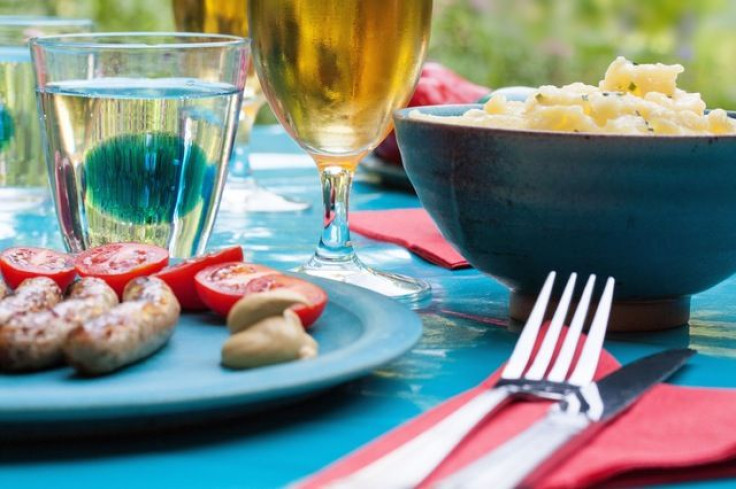5 Tips For A Healthy Thanksgiving To Avoid Weight Gain, From Portion Control To Small Plates

Thanksgiving marks the beginning of gluttony and weight gain that will continue well into the holiday season. Despite every attempt to avoid fat- and calorie-laden foods, we fall into temptation before we even get to the main course. A couple of potato salads, meatloaf, and pumpkin pie slices later, we begin to wonder: "Is eating healthy on Thanksgiving impossible?”
The holiday season is challenging for everyone, and staying on track with our diet can be daunting. Previous research has found people’s perceived weight gain varies between zero and 6.7 pounds with an average of 3.5, but their actual weight gain was just under 1 pound. In reality, "holiday weight" may be nothing to panic over, but we should still practice healthy eating, most importantly, portion control.
Below are five eating tips for a thinner, healthier Thanksgiving dinner.
Don't Skip Breakfast
A healthy Thanksgiving dinner starts before we even have our first bite. Many of us opt to skip or limit breakfast to save the calorie overindulgence for later, but this can lead to more overeating at dinner. A 2013 study in The American Journal of Clinical Nutrition found consuming a protein-packed breakfast promotes satiety later in the day, reducing mindless snacking. We're more likely to feel fuller throughout the day, and eat a smaller dinner, and fewer nighttime snacks.
Dr. Lori Shemek, a diet and nutrition expert, explains that protein promotes satiety due to its ability to balance blood sugar, preventing blood sugar spikes and precipitous drops that can lead to hunger and overeating.
"Protein, like fat, is metabolized slower than carbohydrates which allows time for the brain to register you have had enough food," she told Medical Daily.
Start With Smaller, Red Plates
Our first impulse is to reach for a larger plate that can fit all our food. However, to practice portion control, it's best to choose our plate wisely. Appetizers, such as soup or salad, help to reduce a higher food intake throughout dinner.
Tory Tedrow, a registered dietitian and head of nutrition for the app SugarChecked, suggests to start off with broth-based soups and salads, since they are high in water, and therefore, filling.
"Starting a meal with one of these lets you fill up on low-calorie foods before diving into the more indulgent dishes allowing you to eat smaller portions," she told Medical Daily.
Liz Cort, certified personal trainer and founder and president of Team Fit, suggests using a smaller plate, and focusing on adequate vegetable, and lean protein portions when serving our own dish. If we're hungry later on, she suggests eating a high fiber starch, and pairing it with some more vegetables. Digesting starch with an animal protein helps to ease the digestive process.
“Both starches and animal proteins take approximately 3 to 5 hours to pass the stomach, while vegetables are much quicker" she told Medical Daily.
Using a red-colored plate can also curb overindulgence. A 2013 study in Appetite found people tend to eat, or use less of things on red dishes, whether it’s chocolate or hand cream. A red plate with a smaller circumference will help you practice portion control effortlessly.
Pick A Healthy Turkey
Turkey can come in white or dark meat, but several experts suggest if you have an option, white, skinless turkey breast is the leanest of all choices. Skinless dark meat contains more fat than white meat, according to Shemek. However, white meat tends to be the driest, which can lead some people to overcompensate with high-calorie gravy. Whether you decide to go skinless white or dark, either option contains fewer calories than eating turkey with the skin.
Do Eat Dessert, But Wisely
Desserts are calorie-laden sweet traps we fall victim to in a moment of weakness. A few bites of dessert should be enough to satisfy our sweet tooth. Sticking with a classic, such as a slice of pumpkin pie, or any berry pie, is a healthier choice as the antioxidants and phytonutrients help promote weight loss and optimal health.
"Both pumpkin and berries are low-sugar foods and help prevent the blood sugar swings of other traditional Thanksgiving desserts such as pecan pie," said Shemek.
Don't Drink Your Calories
A glass of wine for dinner, followed by several toasts later, can add on the calories quickly. Rebecca Lewis, an in-house registered dietician at HelloFresh, suggests we avoid excess alcohol — drinking our calories. She has outlined the calorie intake for the following drinks below:
1 glass of wine = 5 fluid ounces = 125 calories
1 can of beer = 12 fluid ounces = 154 calories
1 shot = one and a half fluid ounces = 96 calories
Shemek also suggests trying this mental trick: divide the plate into 3 sections, with half the plate for veggies, one-quarter for protein, and one-quarter for carbs.
She suggests: “Eat the veggies first as they are high in fiber, which sends the message to the brain, 'you are well on your way to having enough food.'”
Remember to eat only until you are satisfied, or until you feel 80 percent full.
Enjoy Thanksgiving without the guilt, or the weight gain.



























